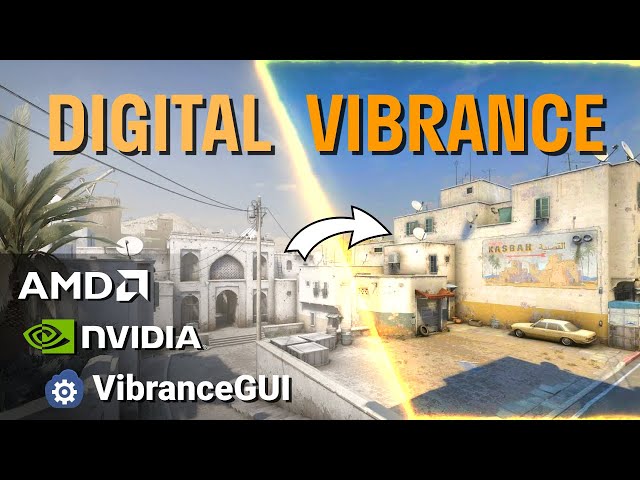In the dynamic world of digital entertainment, the pursuit of a visually stunning experience has driven the development of tools that go beyond the conventional settings provided by graphics cards.
Among these tools, VibranceGUI has emerged as a beacon for users seeking to automate and optimize color saturation, specifically tailored for both NVIDIA’s Digital Vibrance Control and AMD’s Saturation. In this article, we’ll delve into the unique features of VibranceGUI, focusing on its seamless automation, user-friendly interface, and its compatibility with popular graphics card platforms.
Understanding the Need for Automation
Traditionally, adjusting color settings on graphics cards involved navigating through complex control panels, making it a cumbersome process for users who wanted a more dynamic and automated solution. VibranceGUI addresses this need by offering automation for both NVIDIA and AMD users, allowing them to enhance color saturation effortlessly. This feature is particularly valuable for gamers who want a hassle-free way to optimize visuals for different games without manual adjustments.
Key Features
Automated NVIDIA Digital Vibrance Control:
VibranceGUI takes advantage of NVIDIA’s Digital Vibrance Control, a feature that allows users to adjust the vibrancy of colors on their displays. By automating this process, VibranceGUI ensures that users can enjoy an enhanced visual experience without the need for constant manual adjustments.
AMD Saturation Automation:
AMD users can rejoice, as VibranceGUI seamlessly integrates with AMD’s Saturation controls. This automation streamlines the process of adjusting color saturation, providing AMD users with a user-friendly solution to enhance visuals across various applications and games.
User-Friendly Interface:
Despite its advanced capabilities, VibranceGUI maintains a user-friendly interface. The controls are intuitive, allowing users to navigate through settings effortlessly. The automation process is straightforward, making it accessible for users of all levels of technical expertise.
VAC Safe:
VibranceGUI takes user security seriously, ensuring that it is Valve Anti-Cheat (VAC) safe. This means that users can enjoy the benefits of enhanced visuals without compromising the integrity of their gaming accounts or facing potential bans in VAC-protected games.
Lightweight Resource Usage:
One of VibranceGUI’s strengths is its minimal impact on system resources. It operates in the background with a negligible footprint on CPU and memory usage, ensuring that users can enjoy an optimized visual experience without sacrificing overall system performance.
Applications in Gaming
Game-Specific Visual Enhancements:
Gamers often encounter varying visual styles across different games. With VibranceGUI’s automation, users can set specific color saturation levels for each game, ensuring that the visuals are tailored to match the aesthetics of the gaming environment.
Effortless Optimization:
Automating NVIDIA’s Digital Vibrance Control and AMD’s Saturation means that users no longer need to manually tweak settings for each game. VibranceGUI takes care of the adjustments in the background, providing gamers with a hassle-free way to enhance visuals.
Dynamic Visuals for Streaming:
Streamers can benefit from VibranceGUI’s automation by ensuring that their audience enjoys a visually appealing stream. Whether switching between different games or applications, the automated color adjustments create a consistent and engaging visual experience.
Applications in Content Creation
Color Accuracy for Designers:
Designers and content creators working on platforms that support NVIDIA and AMD can utilize VibranceGUI to maintain color accuracy across their creative projects. The automation feature streamlines the design process, allowing for a more efficient workflow.
Optimized Video Editing:
Video editors can leverage VibranceGUI’s automation to ensure consistent color grading across different video projects. This is particularly valuable when working on a variety of content that requires specific visual styles.
Photography Editing Precision:
Photographers engaged in photo editing can benefit from VibranceGUI’s automated color adjustments. This feature ensures that the saturation levels are optimized for accurate and vibrant representation of images.
Community Support and Updates
VibranceGUI’s commitment to user satisfaction is reflected in its active community support. The open-source nature of the software encourages user contributions, leading to regular updates and improvements. Users can participate in forums, access tutorials, and contribute to the ongoing development of VibranceGUI.
Installation and Configuration
Getting started with VibranceGUI is a straightforward process. Users can download the software from the official website and follow the simple installation instructions. The configuration interface is designed for ease of use, allowing users to customize settings and preferences without any technical hurdles.
Conclusion
VibranceGUI’s automation of NVIDIA’s Digital Vibrance Control and AMD’s Saturation adds a new dimension to the visual experience for gamers, designers, and content creators. Its user-friendly interface, coupled with the seamless integration with popular graphics card platforms, makes it a powerful and accessible tool for enhancing visuals across various applications. Whether you’re a gamer seeking effortless optimization or a content creator aiming for color accuracy, VibranceGUI stands as a versatile solution that brings out the true vibrancy of digital content.
